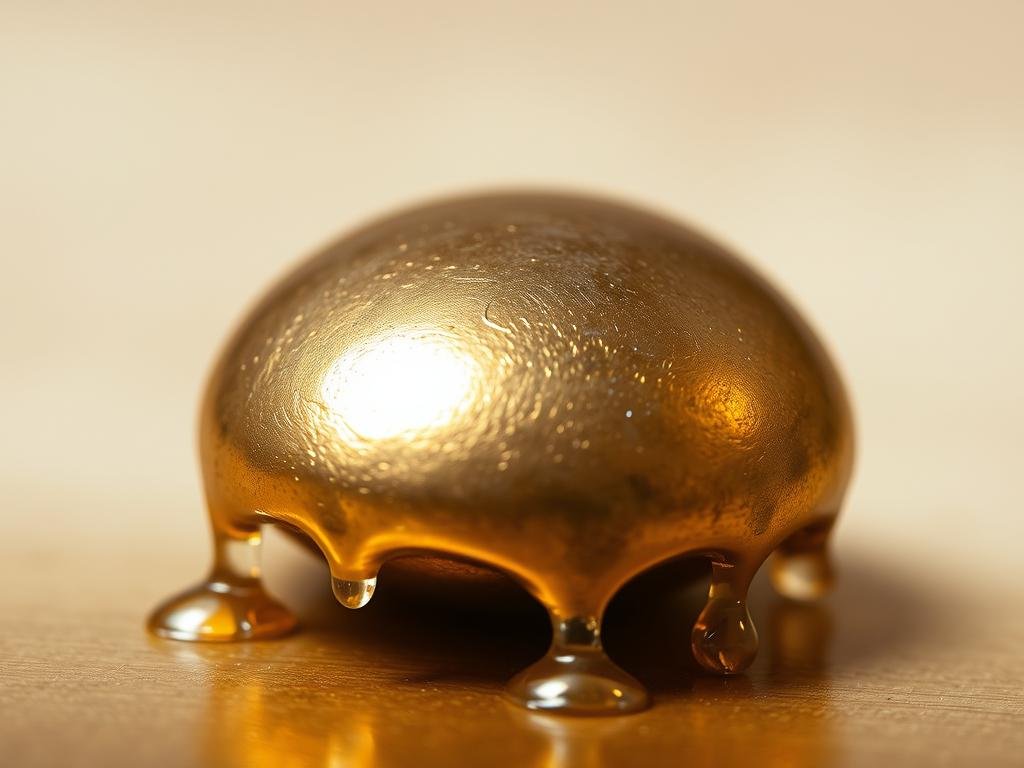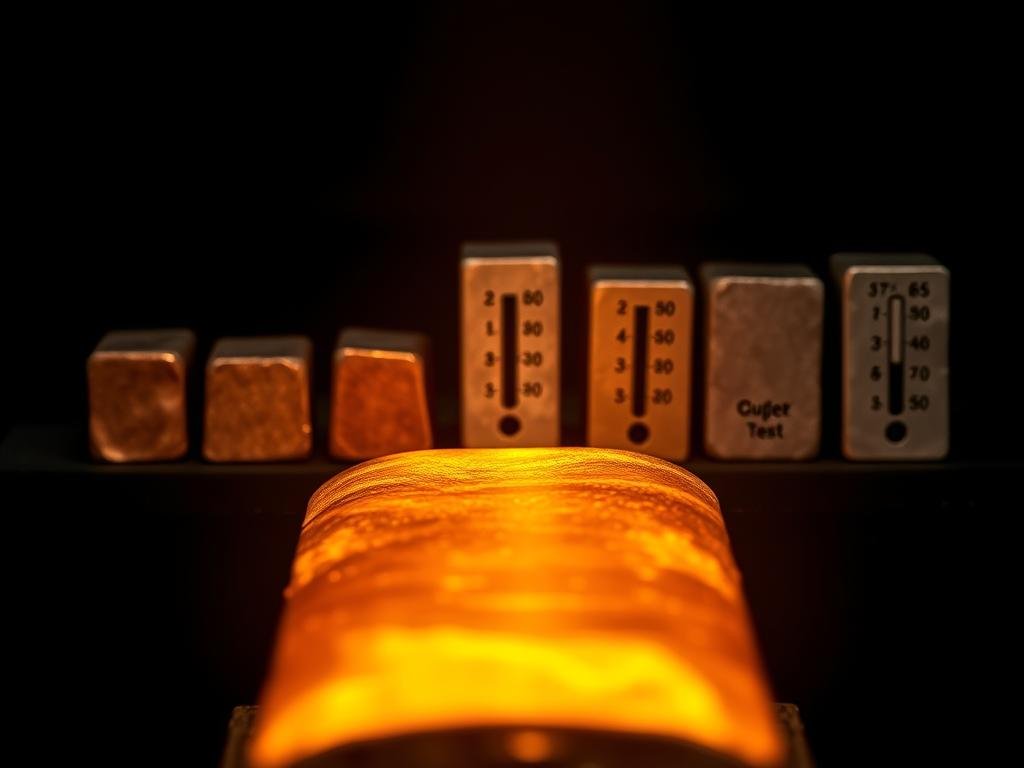Brass, an alloy made by combining copper and zinc, is widely used across various industries due to its unique properties, including corrosion resistance and aesthetic appeal.
Der Temperatur bei dem Messing schmilzt, ist nicht festgelegt, sondern liegt in einem Bereich, typischerweise zwischen 890°C und 1000°C (1650°F und 1830°F), abhängig von seinem Komposition.
Understanding the melting Punkt Dieses Metalllegierung ist entscheidend für Herstellungsprozesse und Materialauswahl.
The varying proportions of copper and zinc in brass affect its melting behavior, making it essential to consider these factors when working with this alloy.
Verstehen von Messing als Legierung
Messing, ein Legierung, die hauptsächlich aus Kupfer und Zink besteht, bietet eine einzigartige Kombination von Eigenschaften, die sie wertvoll machen Material in verschiedenen Branchen.
The properties of brass are significantly influenced by the proportion of its main Elemente, Kupfer und Zink.
Zusammensetzung und Eigenschaften von Messing
Messing ist grundsätzlich eine Legierung, die hauptsächlich aus Kupfer und Zink besteht. Der typische Kupfergehalt liegt zwischen 55 % und 95 %, und der Zinkgehalt zwischen 5 % und 45 %.
| Element | Typischer Bereich |
|---|---|
| Kupfer | 55% – 95% |
| Zink | 5% – 45% |
| Lead | 0.5% – 3.5% |
| Tin | 0.5% – 1.5% |
The ratio between copper and zinc significantly influences the Eigenschaften aus Messing, einschließlich seiner Farbe, Festigkeit, Duktilität und Schmelzpunkt.
Zusätzliche Elemente können in geringeren Mengen vorhanden sein, um bestimmte Eigenschaften zu verbessern.
- The versatility of brass as a Material stammt aus seiner verstellbaren Zusammensetzung.
- Messing hat ausgezeichnete mechanische und Verschleißfestigkeitseigenschaften.
- It’s ideal for creating precision instruments, ship parts, and other components.
The Melting Point of Brass Explained
Brass, being an alloy, doesn’t have a precise melting point like pure metals; instead, it exhibits a melting range. This characteristic is crucial for understanding its behavior under various thermal conditions.
Definition of Melting Point in Metallurgy
In metallurgy, the melting point is defined as the temperature at which a solid metal transitions to a liquid state. This phase change is critical in determining the material’s structure and properties. As “the melting point is the temperature at which a material undergoes a change of state”, es ist eine grundlegende Eigenschaft, die beeinflusst, wie Materialien verarbeitet werden.
Typical Melting Range for Brass
The typical melting range for brass falls between 900°C and 940°C (1650°F and 1720°F), though this can vary based on the specific brass composition. Unlike pure metals, brass goes through a “mushy” phase during melting, where solid and liquid states coexist. Understanding this melting range is crucial for manufacturing processes like casting, where precise temperature control determines the quality of the final product.
Faktoren, die den Schmelzpunkt von Messing beeinflussen
Understanding the factors that affect the melting point of brass is crucial for various industrial applications. The melting behavior of brass is influenced by its composition and microstructure.
Kupfer-zu-Zink-Verhältnis Einfluss
The copper-to-zinc ratio is a primary factor affecting the melting point of brass. A higher copper content, which melts at 1085°C, raises the melting point, while a higher zinc content, melting at 419.5°C, lowers it. For instance, brass with approximately 70% copper and 30% zinc typically melts at around 940°C, whereas brass with 60% copper and 40% zinc melts at around 900°C.
Influence of Additional Alloying Elements
Additional alloying elements such as lead, tin, and aluminum can significantly alter the melting characteristics of brass. Lead, in particular, is known for lowering the melting point. These elements can change the alloy’s microstructure, thereby affecting its melting behavior.
Effect of Impurities and Microstructure
Impurities in brass can disrupt its regular atomic structure, often resulting in a lower melting point. The microstructure, including grain size and distribution, also affects how heat is distributed throughout the material during heating, influencing the melting behavior.
| Faktor | Auswirkung auf den Schmelzpunkt |
|---|---|
| Copper Content | Erhöht den Schmelzpunkt |
| Zinc Content | Decreases melting point |
| Additional Alloying Elements | Can lower or alter melting point |
| Impurities | Can lower melting point |

Melting Points of Different Brass Grades
Understanding the melting points of various brass alloys is crucial for manufacturing processes. Different brass grades have distinct melting temperature ranges due to variations in their composition.
Alpha Brass Melting Temperatures
Alpha brass, containing up to 35% zinc, typically melts between 900°C to 965°C (1650°F to 1770°F). This single-phase microstructure brass is commonly used in applications requiring good cold-working properties.
Beta Brass Melting Temperatures
Beta-Messing, mit einem Zinkgehalt zwischen 35-45%, hat einen höheren Schmelzbereich von 990°C bis 1060°C (1820°F bis 1950°F). Es bietet überlegene Warmumformungseigenschaften, ist aber bei Raumtemperatur spröder.
Special Brass Alloys and Their Melting Points
Specialized brass alloys, such as naval brass and cartridge brass, have unique melting points. Naval brass melts between 900°C to 1060°C (1650°F to 1950°F), while cartridge brass melts between 900°C to 930°C (1650°F to 1710°F). These alloys are designed for specific applications, such as marine hardware and deep-drawing processes.
The melting points of these brass alloys are critical for their processing and application. For instance, high-performance brass alloys containing elements like aluminum or silicon can have melting points exceeding 1000°C (1830°F), offering enhanced strength and heat resistance.
Why Brass Doesn’t Have a Fixed Melting Point
Brass is known for its versatility, but one of its most intriguing properties is its lack of a fixed melting point. This characteristic can be confusing for those familiar with pure metals that have precise melting points.
Die Wissenschaft hinter variablen Schmelzpunkten
Der Grund, warum Messing keinen festen Schmelzpunkt hat, liegt in seiner Zusammensetzung. Als Legierung, die hauptsächlich aus Kupfer und Zink besteht, wird das Schmelzverhalten von Messing durch die unterschiedlichen Schmelzpunkte seiner Bestandteile beeinflusst. Kupfer schmilzt bei 1085°C, während Zink bei 419,5°C schmilzt.
How Composition Creates Temperature Ranges
The combination of copper and zinc in brass results in a melting range rather than a fixed point. As brass is heated, it goes through a “pasty” or “mushy” range where some portions are solid while others are liquid. This temperature range is known as the “solidus-liquidus range.”
- The width of this melting range is influenced by the composition of the brass.
- More complex alloys typically have wider melting ranges.
- The variable melting point of brass is advantageous in certain manufacturing processes like casting.
| Legierungszusammensetzung | Schmelzbereich (°C) |
|---|---|
| High Copper Content | 900-920 |
| High Zinc Content | 880-900 |
The melting range of brass is a critical property that affects its applications. Understanding this property is essential for optimizing manufacturing processes.
Comparing Brass Melting Point to Other Metals
Understanding how brass compares to other metals in terms of melting point is crucial for selecting the right material for various applications. The melting point of an alloy like brass, which is primarily composed of copper and zinc, falls between that of its constituent metals.
Brass vs. Copper and Zinc
Brass melts at approximately 930°C (1710°F), which is between the melting points of copper (1084°C or 1983°F) and zinc (420°C or 787°F). This demonstrates how alloying elements can create materials with intermediate properties, useful for specific engineering applications.
Brass vs. Other Common Metals
Im Vergleich zu anderen gängigen Konstruktionsmetallen hat Messing einen moderaten Schmelzpunkt. Er ist höher als Aluminium (660°C oder 1220°F) und Blei (328°C oder 622°F), aber niedriger als Stahl (1425-1540°C oder 2597-2800°F) und Titan (1670°C oder 3038°F). Dieses macht Messing energieeffizienter für Gießen und Formen als höher schmelzende Metalle.
Metals with Higher and Lower Melting Points
Refractory metals like tungsten (3400°C or 6152°F) and molybdenum (2620°C or 4748°F) have significantly higher melting points than brass, making them suitable for extreme high-temperature applications. Conversely, metals like lead and zinc have lower melting points, making them less suitable for high-temperature uses.

Practical Applications of Brass Melting Point Knowledge
Understanding the melting point of brass is crucial for various industrial applications. Knowing the melting point helps in choosing the right brass material for the right applications, ensuring that the material can withstand the required temperatures without losing its properties.
Manufacturing and Casting Processes
In manufacturing and casting processes, precise knowledge of brass’s melting point is essential. This knowledge helps in setting optimal furnace temperatures, ensuring complete melting without overheating, which can lead to zinc volatilization and altered alloy properties. Foundries rely on melting point data to design efficient casting processes.
Welding and Joining Techniques
For welding and joining techniques, understanding the melting behavior of brass is critical. This understanding affects filler material selection, heat input requirements, and the potential for dezincification in the heat-affected zone. Proper techniques ensure strong and durable joints.
High-Temperature Applications
Engineers designing components for high-temperature environments must consider brass’s melting point as an absolute upper limit. Typically, continuous operating temperatures are limited to no more than 200-300°C below the melting point, ensuring the material’s integrity and performance.
| Anwendung | Temperature Consideration | Brass Alloy Selection |
|---|---|---|
| Manufacturing and Casting | Optimale Ofentemperaturen | High-copper brasses for higher temperature resistance |
| Welding and Joining | Heat input requirements | Leaded brasses for lower processing temperatures |
| High-Temperature Environments | Limiting operating temperatures | Spezielle Messinglegierungen für bestimmte Temperaturbereiche |
How to Properly Melt Brass
Das Schmelzen von Messing erfordert eine sorgfältige Berücksichtigung mehrerer Faktoren, um das gewünschte Ergebnis zu erzielen. Der Prozess beinhaltet das Verständnis der Materialeigenschaften, die Verwendung geeigneter Ausrüstung und die Befolgung eines präzisen Verfahrens.
Equipment and Safety Considerations
Um Messing sicher zu schmelzen, benötigt man einen Ofen, der mindestens 1000°C (1832°F) erreichen kann, Schmelztiegel, die hohen Temperaturen standhalten, sowie Schutzausrüstung wie hitzebeständige Handschuhe und Gesichtsschutz. Sicherheitsaspekte sind von größter Bedeutung aufgrund der extremen Temperaturen und der Gefahr von Metallspritzern sowie Zinkoxid-Dämpfen.
Schritt-für-Schritt-Schmelzprozess
The melting process begins with material preparation, ensuring the brass is clean and dry. The furnace is preheated, and flux is added to prevent oxidation. The brass is then carefully charged into the crucible, and the temperature is monitored throughout the process to ensure it reaches the optimal Schmelztemperatur, typically around 1,650°F (900°C) for common brass alloys.
Häufige Fehler, die vermieden werden sollten
Common mistakes include inadequate ventilation, improper flux usage, overheating, and pouring molten brass into improperly prepared molds. These errors can lead to dangerous situations, such as steam explosions, or result in poor-quality castings.
Fazit
Brass melting point knowledge is vital for optimizing manufacturing processes and material selection. Understanding the brass melting point is essential for anyone working with this versatile material, as it directly impacts manufacturing processes, material selection, and application suitability.
Der Schmelzpunkt von Messing liegt typischerweise zwischen 900°C und 940°C und variiert je nach spezifischer Legierungszusammensetzung. Im Gegensatz zu reinen Metallen hat Messing keinen festen Schmelzpunkt, sondern vielmehr einen Schmelzbereich aufgrund seiner Natur als Legierung. Faktoren, die den Schmelzpunkt beeinflussen, sind Zusammensetzung, Verunreinigungen, Mikrostruktur und externe Bedingungen wie Druck.
Das Wissen um den Schmelzpunkt von Messing ermöglicht es Herstellern, den Energieverbrauch zu optimieren und die Eigenschaften des Materials während der Herstellung zu erhalten. Mit dem Fortschritt der Materialwissenschaften werden ständig neue Messinglegierungen mit veränderten Schmelzeigenschaften entwickelt, um den Anforderungen der modernen Fertigung gerecht zu werden. Durch die Anwendung der in diesem Artikel beschriebenen Prinzipien können Sie fundierte Entscheidungen bezüglich der Auswahl, Verarbeitung und Anwendung von Messing treffen.
